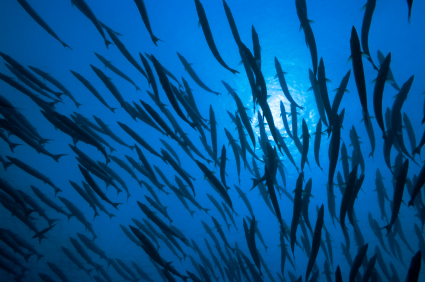Saltwater Blobs Explain Puzzling Ocean Patterns
Subtropical oceans often stratify themselves into layers of warm, salty water overlying progressively colder, fresher layers, covering hundreds of square kilometers. Oceanographers have had trouble explaining this pattern, but in Physical Review Letters, researchers use numerical simulations to show that these layers form because of the action of “fingers” of high-salinity water that penetrate less-salty regions below them. The process could be important for ocean modeling in climate change research and for understanding ocean ecology.
The density of seawater depends on both temperature and salt content. Colder water is denser than warmer water; salty water is denser than fresh. In much of the ocean, the surface layers are warmer and slightly less salty than the deeper layers of water. But strong sunlight and winds at the middle latitudes encourage evaporation, which generates a warm, salty layer of water at the top of the Mediterranean Sea, the middle Atlantic near the Caribbean, and other subtropical seas. Below the warm, salty surface is a layer of cooler, fresher water. And below that is another layer of even colder, fresher water, and so on. If you plot the temperature or salinity of the water versus depth, the graph will look like a staircase. The “steps” have fairly constant temperature and salinity for 10 to 30 meters, and then there is a steep change over one to three meters before the next step.
Oceanographers have long argued over the cause of these staircases, because they would expect a continuous change in temperature and salinity with depth. A common guess was that the water within a step is stirred by blobs of salty water known as “salt fingers,” but researchers couldn’t explain how the flimsy structures could stir such large volumes of water. The answer could be that large clumps of salt fingers are responsible, say Francesco Paparella of the University of Salento in Lecce, Italy, and Jost von Hardenberg of the Institute of Atmospheric Sciences and Climate of the Italian National Research Council in Torino. Paparella and von Hardenberg numerically simulated a slice of seawater with a fixed temperature and salinity at the top and bottom of the slice. Most past simulations of the staircase have assumed that the water flowing out of the top of the slice flowed back into the bottom in a continuous loop—the “periodic boundary conditions” trick that researchers use in many types of simulations, to reduce computational requirements. Paparella and von Hardenberg did not use this trick, so their simulations used an unprecedented number of computer hours.
Initially the water in the simulation had steadily decreasing temperature and salinity from the surface to the ocean floor. But as the simulation evolved, salt fingers began to form. A salt finger is a blob of warm, salty water that happens to dip into the colder, fresher water below it. Since heat diffuses 100 times faster than salt, the blob quickly cools to the temperature of the colder water but stays saltier. The higher density of this saltier water causes it to drift down into even colder water, and the process repeats. More warm salty water is drawn down in its wake, forming a thin finger of salty water. The process also happens in reverse, with colder, fresher fingers absorbing heat as they climb into warmer, saltier water.
Salt fingers can be tens of meters long and only centimeters wide. Paparella and von Hardenberg’s simulations showed several fingers clumping together to form heftier structures capable of stirring large volumes of water. The researchers suggest that the stirring motion of these clumps redistributes heat and salt, creating the relatively uniform layers, and sharp boundaries form between the layers. Once a boundary forms, salt fingers are even more likely to appear at the top of a layer, as denser water from above sinks into less dense water below, further stirring the layer below the boundary. A similar idea was discussed in the 1960s and 70s, but no one was able to observe it until now [1].
“The computational set-up is a little closer to reality” than other simulations have been, says Charlie Doering, a fluid dynamics researcher at the University of Michigan. Doering says the topic is important for climate researchers, who need to improve understanding of vertical ocean mixing, which affects the absorption of heat and carbon dioxide. The process is also critical for food chains, he says, because the vertical mixing brings nutrient-rich water from the depths up to fish and plankton that live closer to the surface.
–Kim Krieger
Kim Krieger is a freelance science writer in Norwalk, Connecticut.
References
- J. S. Turner, ”Double-Diffusive Phenomena,” Ann. Rev. Fluid Mech. 6, 37 (1974)





